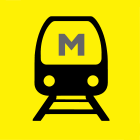Busan Metro Line 4
| Line 4 | |
|---|---|
 | |
 | |
| Overview | |
| Native name |
4호선(4號線) Sa Hoseon |
| Type | Rapid transit |
| System | Busan Subway |
| Status | Operational |
| Termini |
Anpyeong Minam |
| Stations | 14 |
| Services | 1 |
| Operation | |
| Opened | 30 March 2011 |
| Operator(s) | Busan Transportation Corporation |
| Technical | |
| Line length | 10.8 km (6.7 mi) |
| No. of tracks | 2 |
| Track gauge | by tire, outside: 1.7 metres (5 ft 7 in) |
| Electrification | 750 V DC third rail |
Busan Subway Line 4 (4호선) is a rubber-tyred metro line of the Busan Subway network that connects part of Gijang-gun, Busan, and upper Haeundae-gu, Busan, into Dongnae-gu, Busan Korea. It is operated by the Busan Transportation Corporation. Opened on March 30, 2011,[1] the line is a rapid transit (metro) system consisting of 14 stations - 8 underground, 1 on-ground, and 5 above-ground.[2] The line color is blue. A trip through the entire line takes about 24 minutes. Unlike lines 1 to 3 of Busan Subway the trains are driverless and run with pneumatic tires on concrete track (Roll way) between two guide bars.
Lines 3 and 4
While Busan Subway Line 3 was being planned, the planners thought about making what is now Busan Subway Line 4 the 2nd phase of Busan Subway Line 3. However, for several reasons, they have made this 2nd phase into a new line called Busan Subway Line 4.
Archaeology
Compared to Line 3, Line 4 took quite a long time for its construction. There are many reasons for this; however the most significant one is that there were many artifacts found in the construction site of the line, including those from the time of the Three Kingdoms of Korea and the Joseon Dynasty. These artifacts had great historical value,[3] so they caused the completion date of the line to be delayed from its original date of opening in 2008. Some of these artifacts are being displayed inside a historical museum dedicated to this in Suan Station (the museum opened on January 28, 2011).
Car builder
Woojin Industrial system Co., Ltd., supplied urban rubber tire trains for Line 4.[4]
List of stations
| Station Number |
Station name | Transfer | Distance in km |
Total distance |
Location | ||||
|---|---|---|---|---|---|---|---|---|---|
| English | Hangul | Hanja | |||||||
| |
Minam | 미남 | 美南 | 3 | |
|
|
| |
| |
Dongnae | 동래 | 東萊 | 1 | |
| |||
| |
Suan | 수안 (동래읍성임진왜란역사관) | 壽安 (동래읍성임진왜란역사관) |
|
| ||||
| |
Nakmin | 낙민 | 樂民 | |
| ||||
| |
Chungnyeolsa | 충렬사 (안락) | 忠烈祠 (안락) |
|
| ||||
| |
Myeongjang | 명장 | 鳴藏 | |
| ||||
| |
Seodong | 서동 | 書洞 | |
|
| |||
| |
Geumsa | 금사 | 錦絲 | |
| ||||
| |
Banyeo Agricultural Market | 반여농산물시장 | 盤如農産物市場 | |
|
| |||
| |
Seokdae | 석대 | 石坮 | |
| ||||
| |
Youngsan Univ. | 영산대 (아랫반송) | 靈山大 (아랫반송) |
|
| ||||
| |
Dong-Busan College | 동부산대학 (윗반송) | 東釜山大學 (윗반송) |
|
| ||||
| |
Gochon | 고촌 (실로암공원) | 古村 (실로암공원) |
|
|
| |||
| |
Anpyeong | 안평 (고촌주택단지) | 安平 (고촌주택단지) |
|
| ||||
See also
References
- ↑ "'국내 첫 무인경전철' 부산도시철도 4호선 개통". Naver (in Korean). March 30, 2011.
- ↑ "사업개요". 부산교통공사. Retrieved March 14, 2010.
- ↑ "반송선<도시철도 3호선 2단계>, 문화재에 발목잡히나". 엄창현, 오상준. Retrieved March 28, 2010.
- ↑ "(untitled)". Woojin Industrial System Co., Ltd.
External links
| Wikimedia Commons has media related to Busan Subway Line 4. |
- Introduction of Busan Subway Line 4 (Korean text)
| ||||||||||||||||||||||||||||||||||||||||||||||||||